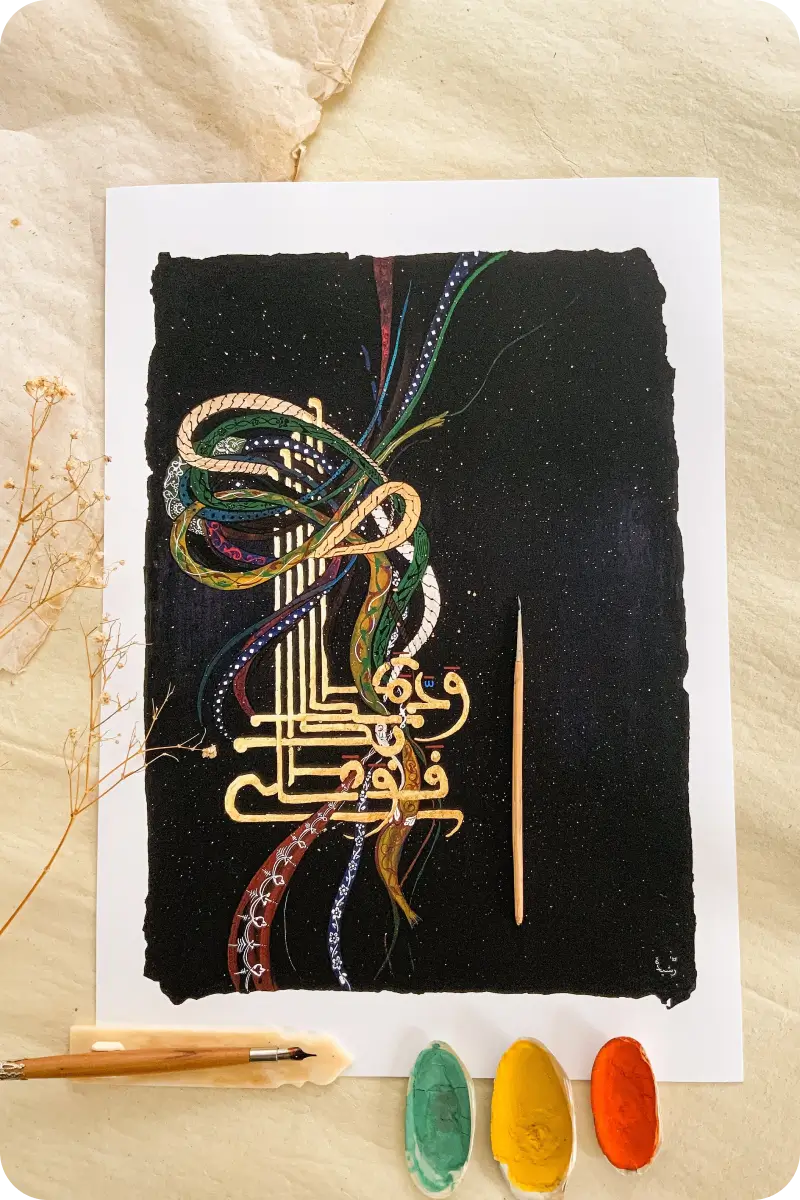Color Therapy and Islamic Art
Written by Shazia Osman

I’ve been meaning to write about this topic for quite some time.
This morning’s Creative Mindfulness class, prompted this conversation and I thought why not write a blog post about this?
There is a fascinating intersection between creativity, spirituality, and emotional healing. In Islamic art, colors are not just used for aesthetic purposes but are deeply symbolic, often reflecting spiritual meanings and emotional states. By understanding and applying the principles of **color therapy** within the context of **Islamic art**, we can harness the power of colors to boost our emotional wellbeing and cultivate inner peace.
**The Symbolism of Colors in Islamic Art**
- **Blue (Serenity and Divine Presence):**
Blue, often seen in Islamic architecture and ceramics, symbolizes the infinite and the divine. Its connection to the sky and water invokes feelings of peace, tranquility, and reflection. Using shades of blue in your art can help soothe anxiety and bring a sense of calm.
- **Green (Harmony and Spirituality):**
Green is considered one of the most sacred colors in Islamic culture, representing paradise, renewal, and life. It is often associated with the Prophet Muhammad (PBUH) and used in mosques and sacred spaces. Incorporating green into your art can promote healing, emotional balance, and spiritual growth.
- **Gold (Divine Light and Illumination):**
Gold is frequently used in Islamic illumination (Tazhib) to signify divine light and the presence of God. It brings a sense of sacredness and splendor to the artwork. Using gold in your designs can uplift your mood and instill a sense of spiritual connection and clarity.
- **Red (Strength and Passion):**
Red represents energy, strength, and vitality. Though less common in Islamic art, when it is used, it symbolizes passion and power. Adding red to your creative work can evoke feelings of motivation, confidence, and action.
- **White (Purity and Peace):**
White is often used in Islamic art to symbolize purity, light, and peace. It brings clarity and a sense of cleanliness, both spiritually and emotionally. Using white in your art, particularly in calligraphy or geometric designs, can create a feeling of spiritual clarity and mental peace.
- **Black (Mystery and Depth):**
Black can signify the unknown, the divine mystery, and the unseen in Islamic art. While sometimes associated with mourning, black is also a grounding and stabilizing color. When used thoughtfully, it can give depth to your artwork, anchoring emotions and creating a sense of focus.
**Using Color Therapy in Islamic Art Practices**
**1. Mindful Color Selection for Emotional Shifts:**
When engaging in Islamic art, consider how you feel and what emotional state you wish to cultivate. Use colors intentionally to guide your emotional journey:
- If you’re feeling overwhelmed, work with blues and greens to induce calm and balance.
- If you need energy or motivation, incorporate reds and golds for strength and empowerment.
- If you’re seeking spiritual clarity or reflection, use white or light shades to create a sense of purity and peace.
**2. Creating Geometric Patterns with Therapeutic Colors:**
Islamic geometric patterns are inherently meditative, with their symmetry and repetition. You can enhance this practice by choosing colors based on the emotional energy you want to invoke. For example, creating a mandala with alternating blue and gold tones can help you focus on peace and spiritual insight, while a red and black pattern might evoke inner strength and resilience.
**3. Tazhib (Illumination) with Healing Colors:**
Tazhib, or the art of illumination, often involves detailed floral or geometric designs surrounding text. By adding colors like green for harmony or gold for divine light, you can create pieces that resonate with your emotional and spiritual state. The process of carefully selecting colors can also be a therapeutic, mindful practice in itself.
**4. Calligraphy and Emotional Expression Through Color:**
Calligraphy, a central feature of Islamic art, can also be enhanced with color therapy. Instead of traditional black ink, try using colored inks to express different emotions. For example, writing an uplifting verse or phrase in shades of green or blue can help reinforce feelings of hope and tranquility.
**5. Art Therapy for Emotional Healing:**
As an art therapy practice, creating Islamic-inspired art with intentional colors can help release suppressed emotions and facilitate healing. Whether you're coloring a geometric design or painting a calligraphic piece, the act of applying therapeutic colors can improve emotional resilience and foster a sense of wellbeing.
**How to Incorporate Color Therapy in Your Daily Creative Practice**
1. **Color Journaling:** Each day, create a simple piece of art—whether a calligraphic letter, a geometric shape, or an abstract design—using a color that reflects your current mood or the emotional state you wish to cultivate.
2. **Personal Mandalas:** Create mandalas or Islamic geometric patterns with colors that symbolize balance, growth, or peace. Use them as visual reminders to meditate on throughout your day.
3. **Zikr and Color:** While engaging in Zikr or spiritual reflection, use colors that resonate with your spiritual practice. For example, using green to symbolize renewal during personal Zikr sessions can help deepen your spiritual connection.
---
By blending **color therapy** with the rich traditions of **Islamic art**, you can create an empowering and emotionally healing practice that not only enriches your artistic expression but also nurtures your emotional and spiritual wellbeing. Whether you're seeking calm, clarity, or strength, the mindful use of color can guide you toward a more balanced, harmonious inner life.








Leave a comment